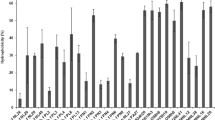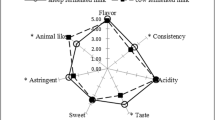Abstract
The present study was conducted to find the potential of Lactococcus lactis strains naturally present in raw and fermented milk as probiotics and to evaluate their safety and some technological characteristics. There are numerous studies that evaluated probiotic properties of lactococci, nevertheless, limited studies on the probiotic potential of lactococci isolated from raw milk or dairy products were performed. Strains isolation from raw milk or dairy products and their characterization is important when selection of starter strains for the production of functional dairy foods is performed. Depending on aroma production and acidifying activity, 33 L. lactis strains were selected out of 169 and evaluated for safety, technological and probiotic properties. These strains were screened for antibiotic sensitivity, enzymatic activity, hemolytic and gelatinase activities. The strains were also assessed for resistance to bile salts and acid, growth in bile acids and cholesterol, cell surface hydrophobicity. Based on the obtained results, two strains with the best probiotic potential were selected. These two L. lactis strains, with 51% and 67% survival at low pH and more than 80% resistance to various bile salt concentrations, proved their resistance in vitro to gastric conditions. Also these strains proved to be good acidifiers (the pH of milk was reduced by at least 1 unit in 6 h at 30–37 °C) and can be used in the development of functional dairy foods as starter cultures.

Similar content being viewed by others
References
Linares DM, Gómez C, Renes E et al (2017) Lactic acid bacteria and bifidobacteria with potential to design natural biofunctional health-promoting dairy foods. Front Microbiol 8:846. https://doi.org/10.3389/fmicb.2017.00846
Ruiz-Moyano S, Gonçalves dos Santos MTP, Galván AI et al (2019) Screening of autochthonous lactic acid bacteria strains from artisanal soft cheese: probiotic characteristics and prebiotic metabolism. LWT-Food Sci Technol. https://doi.org/10.1016/j.lwt.2019.108388
Colombo M, Castilho NPA, Todorov SD, Nero LA (2018) Beneficial properties of lactic acid bacteria naturally present in dairy production. BMC Microbiol 18:219. https://doi.org/10.1186/s12866-018-1356-8
FAO (2001) Probiotics in food: Health and nutritional properties and guidelines for evaluation. Food Nutr Pap. https://doi.org/10.1201/9781420009613.ch16
Hossain MI, Mizan MFR, Ashrafudoulla M et al (2020) Inhibitory effects of probiotic potential lactic acid bacteria isolated from kimchi against Listeria monocytogenes biofilm on lettuce, stainless-steel surfaces, and MBECTM biofilm device. LWT 118:108864. https://doi.org/10.1016/j.lwt.2019.108864
Choi EA, Chang HC (2015) Cholesterol-lowering effects of a putative probiotic strain Lactobacillus plantarum EM isolated from kimchi. LWT Food Sci Technol 62:210–217. https://doi.org/10.1016/j.lwt.2015.01.019
Rastogi S, Mittal V, Singh A (2019) In vitro evaluation of probiotic potential and safety assessment of Lactobacillus mucosae strains isolated from donkey’s lactation. Probiot Antimicro Prot. https://doi.org/10.1007/s12602-019-09610-0
Tidona F, Meucci A, Povolo M et al (2018) Applicability of Lactococcus hircilactis and Lactococcus laudensis as dairy cultures. Int J Food Microbiol 271:1–7. https://doi.org/10.1016/j.ijfoodmicro.2018.02.015
Cavanagh D, Fitzgerald GF, McAuliffe O (2015) From field to fermentation: The origins of Lactococcus lactis and its domestication to the dairy environment. Food Microbiol 47:45–61. https://doi.org/10.1016/j.fm.2014.11.001
Song AAL, In LLA, Lim SHE, Rahim RA (2017) A review on Lactococcus lactis: From food to factory. Microb Cell Fact 16:55. https://doi.org/10.1186/s12934-017-0669-x
Perin LM, Miranda RO, Todorov SD et al (2014) Virulence, antibiotic resistance and biogenic amines of bacteriocinogenic lactococci and enterococci isolated from goat milk. Int J Food Microbiol 185:121–126. https://doi.org/10.1016/j.ijfoodmicro.2014.06.001
García-Hernández Y, Pérez-Sánchez T, Boucourt R et al (2016) Isolation, characterization and evaluation of probiotic lactic acid bacteria for potential use in animal production. Res Vet Sci 108:125–132. https://doi.org/10.1016/j.rvsc.2016.08.009
FAO/WHO (2002) Guidelines for the evaluation of probiotics in food. Food and Agriculture Organization of the United Nations and World Health Organization Group Report.(London Ontario, Canada). FAO Food Nutr Pap 85
Zielińska D, Rzepkowska A, Radawska A, Zieliński K (2015) In vitro screening of selected probiotic properties of Lactobacillus strains isolated from traditional fermented cabbage and cucumber. Curr Microbiol 70:183–194. https://doi.org/10.1007/s00284-014-0699-0
de Simone C (2019) The unregulated probiotic market. Clin Gastroenterol Hepatol 17(5):809–817. https://doi.org/10.1016/j.cgh.2018.01.018
de Melo Pereira GV, de Oliveira CB, Magalhães Júnior AI et al (2018) How to select a probiotic? A review and update of methods and criteria. Biotechnol Adv 36(8):2060–2076. https://doi.org/10.1016/j.biotechadv.2018.09.003
Yerlikaya O (2019) Probiotic potential and biochemical and technological properties of Lactococcus lactis ssp. lactis strains isolated from raw milk and kefir grains. J Dairy Sci 102:124–134. https://doi.org/10.3168/jds.2018-14983
Andreoletti O, Baggesen DL, Bolton D et al (2012) Scientific Opinion on the maintenance of the list of QPS biological agents intentionally added to food and feed (2013 update). EFSA J 11:3449. https://doi.org/10.2903/j.efsa.2013.3449
Domingos-Lopes MFP, Stanton C, Ross PR et al (2017) Genetic diversity, safety and technological characterization of lactic acid bacteria isolated from artisanal Pico cheese. Food Microbiol 63:178–190. https://doi.org/10.1016/j.fm.2016.11.014
Kondrotiene K, Kasnauskyte N, Serniene L et al (2018) Characterization and application of newly isolated nisin producing Lactococcus lactis strains for control of Listeria monocytogenes growth in fresh cheese. LWT Food Sci Technol 87:507–514. https://doi.org/10.1016/j.lwt.2017.09.021
Dal Bello B, Cocolin L, Zeppa G et al (2012) Technological characterization of bacteriocin producing Lactococcus lactis strains employed to control Listeria monocytogenes in Cottage cheese. Int J Food Microbiol 153:58–65. https://doi.org/10.1016/j.ijfoodmicro.2011.10.016
Maragkoudakis PA, Mountzouris KC, Psyrras D et al (2009) Functional properties of novel protective lactic acid bacteria and application in raw chicken meat against Listeria monocytogenes and Salmonella enteritidis. Int J Food Microbiol 130:219–226. https://doi.org/10.1016/j.ijfoodmicro.2009.01.027
Belicová A, Mikulášová M, Dušinský R (2013) Probiotic potential and safety properties of Lactobacillus plantarum from Slovak Bryndza cheese. Biomed Res Int 2013:760298. https://doi.org/10.1155/2013/760298
Thirabunyanon M, Boonprasom P, Niamsup P (2009) Probiotic potential of lactic acid bacteria isolated from fermented dairy milks on antiproliferation of colon cancer cells. Biotechnol Lett 31:571–576. https://doi.org/10.1007/s10529-008-9902-3
Han Q, Kong B, Chen Q et al (2017) In vitro comparison of probiotic properties of lactic acid bacteria isolated from Harbin dry sausages and selected probiotics. J Funct Foods 32:391–400. https://doi.org/10.1016/j.jff.2017.03.020
Lee Y-K, Puong K-Y (2002) Competition for adhesion between probiotics and human gastrointestinal pathogens in the presence of carbohydrate. Br J Nutr 88:101–108. https://doi.org/10.1079/bjn2002635
Allam MGM, Darwish AMG, Ayad EHE et al (2017) Lactococcus species for conventional Karish cheese conservation. LWT Food Sci Technol 79:625–631. https://doi.org/10.1016/j.lwt.2016.11.032
Abdollahzadeh SM, Zahedani MR, Rahmdel S et al (2018) Development of Lactobacillus acidophilus-fermented milk fortified with date extract. LWT Food Sci Technol 98:577–582. https://doi.org/10.1016/j.lwt.2018.09.042
Franciosi E, Settanni L, Cavazza A, Poznanski E (2009) Biodiversity and technological potential of wild lactic acid bacteria from raw cows’ milk. Int Dairy J 19:3–11. https://doi.org/10.1016/j.idairyj.2008.07.008
Reuben RC, Roy PC, Sarkar SL et al (2019) Isolation, characterization, and assessment of lactic acid bacteria toward their selection as poultry probiotics. BMC Microbiol 19:253. https://doi.org/10.1186/s12866-019-1626-0
de Almeida Júnior WLG, da Ferrari Í et al (2015) Characterization and evaluation of lactic acid bacteria isolated from goat milk. Food Control 53:96–103. https://doi.org/10.1016/j.foodcont.2015.01.013
Schirru S, Todorov SD, Favaro L et al (2012) Sardinian goat’s milk as source of bacteriocinogenic potential protective cultures. Food Control 25:309–320. https://doi.org/10.1016/j.foodcont.2011.10.060
Divisekera DMWD, Samarasekera JKRR, Hettiarachchi C et al (2019) Lactic acid bacteria isolated from fermented flour of finger millet, its probiotic attributes and bioactive properties. Ann Microbiol 69:79–92. https://doi.org/10.1007/s13213-018-1399-y
Ji K, Jang NY, Kim YT (2015) Isolation of lactic acid bacteria showing antioxidative and probiotic activities from kimchi and infant feces. J Microbiol Biotechnol 25:1568–1577. https://doi.org/10.4014/jmb.1501.01077
Zommiti M, Connil N, Ben HJ, Ferchichi M (2017) Probiotic characteristics of Lactobacillus curvatus DN317, a strain isolated from chicken ceca. Probiotics Antimicrob Proteins 9:415–424. https://doi.org/10.1007/s12602-017-9301-y
Abouloifa H, Rokni Y, Bellaouchi R et al (2019) Characterization of probiotic properties of antifungal Lactobacillus strains isolated from traditional fermenting green olives. Probiotics Antimicrob Proteins. https://doi.org/10.1007/s12602-019-09543-8
Miquel S, Beaumont M, Martín R et al (2015) A proposed framework for an appropriate evaluation scheme for microorganisms as novel foods with a health claim in Europe. Microb Cell Fact 14:48. https://doi.org/10.1186/s12934-015-0229-1
Kumar A, Kumar D (2015) Characterization of Lactobacillus isolated from dairy samples for probiotic properties. Anaerobe 33:117–123. https://doi.org/10.1016/j.anaerobe.2015.03.004
Kim SE, Kim YH, Lee H et al (2012) Probiotic properties of lactic acid bacteria isolated from Mukeunji, a long-term ripened kimchi. Food Sci Biotechnol 21:1135–1140. https://doi.org/10.1007/s10068-012-0148-4
Banwo K, Sanni A, Tan H (2013) Technological properties and probiotic potential of Enterococcus faecium strains isolated from cow milk. J Appl Microbiol 114:229–241. https://doi.org/10.1111/jam.12031
García-Ruiz A, González de Llano D, Esteban-Fernández A et al (2014) Assessment of probiotic properties in lactic acid bacteria isolated from wine. Food Microbiol 44:220–225. https://doi.org/10.1016/j.fm.2014.06.015
Caggia C, De Angelis M, Pitino I et al (2015) Probiotic features of Lactobacillus strains isolated from Ragusano and Pecorino Siciliano cheeses. Food Microbiol 50:109–117. https://doi.org/10.1016/j.fm.2015.03.010
Vidhyasagar V, Jeevaratnam K (2013) Evaluation of Pediococcus pentosaceus strains isolated from Idly batter for probiotic properties in vitro. J Funct Foods 5:235–243. https://doi.org/10.1016/j.jff.2012.10.012
Acknowledgement
This research was funded by the European Regional Development Fund according to the supported activity ‘Research Projects Implemented by World-class Researcher Groups' under Measure No. 01.2.2-LMT-K-718.
Author information
Authors and Affiliations
Contributions
KK drafted the manuscript, conducted the research. LL performed statistical analysis. MM and LS were responsible for supervison, revision of the manuscript. VA and DS were responsible for editing. NK conducted the research.
Corresponding author
Ethics declarations
Conflict of interest
The authors declare that they have no conflict of interest.
Additional information
Publisher's Note
Springer Nature remains neutral with regard to jurisdictional claims in published maps and institutional affiliations.
Rights and permissions
About this article
Cite this article
Kondrotiene, K., Lauciene, L., Andruleviciute, V. et al. Safety Assessment and Preliminary In Vitro Evaluation of Probiotic Potential of Lactococcus lactis Strains Naturally Present in Raw and Fermented Milk. Curr Microbiol 77, 3013–3023 (2020). https://doi.org/10.1007/s00284-020-02119-8
Received:
Accepted:
Published:
Issue Date:
DOI: https://doi.org/10.1007/s00284-020-02119-8




